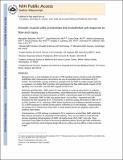Smooth muscle cells orchestrate the endothelial cell response to flow and injury
Author(s)
Balcells-Camps, Mercedes; Martorell Lopez, Jordi; Olive, Carla; Santacana, Marina; Chitalia, Vipul C.; Cardoso, Angelo A.; Edelman, Elazer R.; ... Show more Show less
DownloadEdelman_Smooth muscle.pdf (676.7Kb)
OPEN_ACCESS_POLICY
Open Access Policy
Creative Commons Attribution-Noncommercial-Share Alike
Terms of use
Metadata
Show full item recordAbstract
Background— Local modulation of vascular mammalian target of rapamycin (mTOR) signaling reduces smooth muscle cell (SMC) proliferation after endovascular interventions but may be associated with endothelial cell (EC) toxicity. The trilaminate vascular architecture juxtaposes ECs and SMCs to enable complex paracrine coregulation but shields SMCs from flow. We hypothesized that flow differentially affects mTOR signaling in ECs and SMCs and that SMCs regulate mTOR in ECs.
Methods and Results— SMCs and/or ECs were exposed to coronary artery flow in a perfusion bioreactor. We demonstrated by flow cytometry, immunofluorescence, and immunoblotting that EC expression of phospho-S6 ribosomal protein (p-S6RP), a downstream target of mTOR, was doubled by flow. Conversely, S6RP in SMCs was growth factor but not flow responsive, and SMCs eliminated the flow sensitivity of ECs. Temsirolimus, a sirolimus analog, eliminated the effect of growth factor on SMCs and of flow on ECs, reducing p-S6RP below basal levels and inhibiting endothelial recovery. EC p-S6RP expression in stented porcine arteries confirmed our in vitro findings: Phosphorylation was greatest in ECs farthest from intact SMCs in metal stented arteries and altogether absent after sirolimus stent elution.
Conclusions— The mTOR pathway is activated in ECs in response to luminal flow. SMCs inhibit this flow-induced stimulation of endothelial mTOR pathway. Thus, we now define a novel external stimulus regulating phosphorylation of S6RP and another level of EC-SMC crosstalk. These interactions may explain the impact of local antiproliferative delivery that targets SMC proliferation and suggest that future stents integrate design influences on flow and drug effects on their molecular targets.
Description
available in PMC 2011 May 25
Date issued
2010-05Department
Harvard University--MIT Division of Health Sciences and TechnologyJournal
Molecular Cardiology
Publisher
American Heart Association
Citation
Balcells, M. et al. “Smooth Muscle Cells Orchestrate the Endothelial Cell Response to Flow and Injury.” Circulation 121.20 (2010): 2192–2199. Web.
Version: Author's final manuscript
ISSN
0009-7322
1524-4539